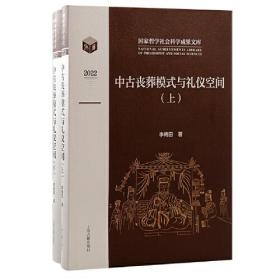
中古丧葬模式与礼仪空间(全二册)
全新正版未拆封
¥ 118.94 4.4折 ¥ 268 全新
仅1件
四川成都
认证卖家担保交易快速发货售后保障
作者李梅田 著
出版社上海古籍出版社
出版时间2023-05
版次1
装帧精装
上书时间2023-09-16
- 最新上架
商品详情
- 品相描述:全新
图书标准信息
- 作者 李梅田 著
- 出版社 上海古籍出版社
- 出版时间 2023-05
- 版次 1
- ISBN 9787573207111
- 定价 268.00元
- 装帧 精装
- 开本 16开
- 纸张 胶版纸
- 页数 716页
- 字数 591.000千字
- 【内容简介】
- 从战国秦汉至隋唐时期,是中国古代社会、文化、思想发生巨大变迁的时期。受其影响,人们对待死亡的态度和处理死亡的方式也发生了巨大的变化。丰富的墓葬材料和大量的传世文献,使这一时期成为死亡考古学研究的极佳范例。针对中古时期墓葬考古的实际,把墓葬当成古人处理死亡的方式和对待死亡的态度的遗存,主要基于三个关键概念:丧葬空间、丧葬仪式、丧葬观念。其中,丧葬空间是处理死亡的礼仪空间,包括地面墓园和地下墓室两部分,在空间功能上又包括埋葬空间和祭祀空间,通过归纳空间形态,构建每个时期的丧葬模式。丧葬礼仪是墓葬遗存反映的丧葬行为,从静态的考古遗存观察动态的人类活动,从空间形态复原古代丧葬礼仪的场景,历史文献中对中古丧葬礼仪的详细记载,为我们复原丧葬行为和场景提供了极为便利的条件。丧葬观念是指在主流意识形态、宗教和民间信仰的综合影响之下人们对待死亡的态度,中古时期主流意识形态受到儒家、玄学、道教、佛教等多重影响,各个时期对待死亡的态度也相应做出改变,这些在丧葬空间、器物、图像等方面都有着具体的表现。
- 【作者简介】
- 李梅田,中国人民大学历史学院考古文博系教授、博士生导师,国家社科基金重大招标项目《隋唐五代壁画墓与中古文化变迁研究》首席专家。1987—1994、1999—2003年在北京大学考古文博学院学习,获历史学博士学位。主要从事汉唐考古、美术考古的教学与研究,重点关注中古社会与文化艺术的变迁。撰有《魏晋北朝墓葬的考古学研究》《中国古代物质文化史·魏晋南北朝》《葬之以礼:魏晋南北朝丧葬礼俗与文化变迁》等专著和《六朝文明》《粟特银器》等译著。
- 【目录】
-
前 言 / 001
上 卷
第一章 认识墓葬:墓葬考古研究方法论的回顾 / 003
一、 考古学理论下的墓葬研究 / 003
从文化历史考古学到新考古学 / 004
后过程考古学 / 007
“过渡礼仪”理论 / 008
二、 作为礼制的墓葬研究 / 011
三、 作为礼仪空间的墓葬研究 / 018
四、 作为观念史的墓葬研究 / 022
五、 本书的思路与结构 / 026
第二章 魂魄所归:丧葬礼仪的象征性 / 029
一、 魂魄二元论 / 029
二、 招魂礼 / 031
三、 寓情于礼的丧葬礼仪 / 035
四、 藏形于墓 / 038
五、 安魂于庙 / 041
六、 墓祭引起的墓葬功能转变 / 045
七、 小结 / 049
第三章 黄泉之下:先秦至西汉井椁式的丧葬模式 / 060
一、 黄泉与幽都 / 060
二、 藏形的井椁 / 063
史前木椁的出现 / 063
殷商井椁的构筑 / 064
周代井椁的变革 / 069
秦汉时期的井椁 / 074
墓道的礼仪功能 / 079
三、 陈器之道 / 081
器物的来源 / 081
器物的礼仪含义 / 083
四、 丧葬美术的兴起 / 090
葬具画像 / 090
漆器画像 / 094
帛画 / 096
五、 小结 / 100
第四章 宅第内外:汉代宅第化的丧葬模式 / 112
一、 秦汉帝陵陵园空间 / 112
秦始皇陵开创的陵寝制度 / 112
西汉陵寝制度 / 116
东汉陵寝制度的变革 / 125
二、 墓室的宅第化 / 134
空间形态的新旧转变 / 134
西汉诸侯王墓的宅第化 / 138
东汉宅第墓室的普及 / 144
三、 祭祀空间的配置 / 149
墓地的祭祀设施 / 149
墓内的祭祀空间 / 154
四、 陈器之道的转变 / 169
五、 丧葬美术的勃兴 / 173
画像的原境与主题 / 174
画像的结构与叙事 / 189
六、 丧葬中的道教与佛教元素 / 195
道教元素 / 195
佛教元素 / 211
七、 小结 / 214
第五章 微缩宇宙:魏晋变革下的丧葬模式 / 219
一、 魏晋模式的形成 / 219
二、 墓室空间形态 / 227
墓室的单室化 / 227
魏晋模式的传播 / 234
三、 墓内祭祀与空间营造 / 241
四、 魏晋墓室画像 / 246
河西地区 / 248
东北地区 / 255
南方地区 / 268
五、 遣策与随葬之物 / 269
六、 小结 / 275
下 卷
第六章 复古创新:南北朝地域社会中的丧葬模式 / 281
一、 地域社会中的丧葬模式 / 281
二、 墓地空间与设施 / 300
从平城到洛阳 / 300
邺城与长安 / 309
建康地区 / 311
三、 墓室空间 / 317
平城 / 317
洛阳 / 324
邺城与晋阳 / 329
长安与原州 / 335
建康与襄阳 / 339
四、 丧葬图像的场景与主题 / 342
北朝石葬具画像 / 342
北朝墓室壁画 / 387
南朝画像砖 / 409
五、 若即若离的佛教与丧葬 / 426
佛教图像在墓室空间中的意义 / 428
平城墓葬中的佛教意涵 / 430
佛殿式的墓室:邢合姜石椁 / 436
仙佛同墓:长川1号墓 / 443
墓寺一体:方山陵园 / 447
以窟为墓:瘗窟 / 449
佛教与丧葬的“边界”与“合作” / 452
六、 小结 / 456
地域传统的形成 / 456
空间形态 / 457
石葬具画像 / 459
墓室壁画 / 460
佛教对传统丧葬的影响 / 462
第七章 秩序重建:隋唐一统下的丧葬模式 / 478
一、 陵园空间的承旧与创新 / 479
空间布局的演变 / 479
等级秩序的形成 / 492
陵园内的礼仪活动 / 495
二、 地下的墓室空间 / 498
隋代的埋葬方式 / 499
唐墓的等级秩序 / 505
三、 画像的配置与内容 / 518
石葬具画像 / 518
墓室壁画的空间意涵 / 540
四、 关中模式的对外辐射 / 579
京畿以外的高等级唐墓 / 580
漠北突厥贵族墓 / 593
五、 小结 / 597
第八章 结语:不知死,焉知生? / 601
一、 中古生死观的变迁 / 601
二、 反思墓葬研究的目的 / 609
三、 刍议死亡考古学 / 612
丧葬空间 / 612
丧葬仪式 / 616
丧葬观念 / 622
参考文献 / 625
插图索引 / 683
表格索引 / 691
后 记 / 693
Summary / 695
CONTENTS
Preface / 001
Chapter 1 Understanding Burials: A Review of the Theories on Burial
Archaeology / 003
Archaeological Theories on Burials / 003
From Historical Archaeology to New Archaeology / 004
Post-Processual Archaeology / 007
iii. Theory of “Rite of Passage” / 008
Burials and Ritual Systems / 011
III. Burials and Ritual Spaces / 018
Burials and Concept History / 022
Ideas, Methodology and Outline / 026
Chapter 2 Where the Soul Belongs: Symbolism of Funeral Rites / 029
Dualism of Bodily Soul and Spiritual Soul / 029
Ceremony of Soul-Summoning / 031
III. Funeral Rites with Emotion / 035
Hiding the Bodily Soul in a Tomb / 038
Resting the Spiritual Soul in a Temple / 041
Sacrificial Offering at the Cemetery and Changing of Tomb’s Function / 045
VII. Conclusion / 049
Chapter 3 Beneath the Yellow Spring: The Burial Mode from the Pre-Qin
Period to the Western Han Dynasty / 060
The Yellow Spring and the Dark Necropolis / 060
Well-Shaped Outer Coffin for Hiding the Body / 063
Occurrence of Well-Shaped Coffins in Prehistorical Tombs / 063
Construction of Well-Shaped Coffins During the Shang Dynasty / 064
iii. Reform of the Well-Shaped Coffins During the Zhou Dynasty / 069
Burials with the Well-Shaped Coffins During the Qin & Han Dynasties / 074
Ceremonial Function of a Tomb Passageway / 079
III. Principles of Burial Objects / 081
The Multiple Sources of Burial Objects / 081
The Ritual Implications of Burial Objects / 083
Emergence of Funerary Art / 090
Paintings on Coffins / 090
Paintings on Lacquerwares / 094
iii. Paintings on Silks / 096
Conclusion / 100
Chapter 4 Underground Residencies: The Burial Mode of House-Modeled Tombs
During the Han Dynasty / 112
Spatial Layout of Imperial Mausoleums in the Qin & Han Dynasties / 112
Mausoleum System of Emperor Qin Shihuang / 112
Mausoleum System of the Western Han Dynasty / 116
iii. Reform of Mausoleum System During the Eastern Han Dynasty / 125
The House-Modeled Tomb Chambers / 134
Transformation of Tomb Chambers’ Structures / 134
Occurrence of House-Modeled Chambers in Princely Tombs During the
Western Han Dynasty / 138
iii. Popularization of House-Modeled Chambers in Princely Tombs During
the Eastern Han Dynasty / 144
III. Arrangement of the Ritual Spaces / 149
The Ground-Level Ritual Space in a Cemetery / 149
The Subterranean Ritual Space in a Tomb / 154
Changing of the Principles of Burial Objects / 169
Prosperity of the Funerary Art / 173
Context and Motifs in Pictorial Representations / 174
Programs and Narratives in Pictorial Representations / 189
Buddhist and Taoist Elements in Funerary Practices / 195
Taoist Elements / 195
Buddhist Elements / 211
VII. Conclusion / 214
Chapter 5 Microcosm: The Burial Mode during the Wei-Jin Period / 219
Formation of the Wei-Jin Mode / 219
Tomb Chamber’s Spatial Forms / 227
Single Chamber Tomb / 227
Spread of the Wei-Jin Mode / 234
III. Ritual Space and Spatial Layout in Tombs / 241
Burial Pictorial Representations during the Wei-Jin Period / 246
Hexi Corridor / 248
Northeast Region / 255
iii. Southern Region / 268
Burial Goods Inventory and Tomb Accompaniments / 269
Conclusion / 275
Chapter 6 Retro Practices and Innovations: The Funeral Modes in Regional
Societies During the Northern & Southern Dynasties / 281
Burial Modes in Regional Societies / 281
Cemetery Space and Facilities / 300
From Pingcheng to Luoyang / 300
Yecheng and Chang’an / 309
iii. Jiankang / 311
III. Underground Burial Spaces / 317
Pingcheng / 317
Luoyang / 324
iii. Yecheng and Jinyang / 329
Chang’an and Yuanzhou / 335
Jiankang and Xiangyang / 339
Scenes and Themes in Funeral Images / 342
Stone Coffin Images of the Northern Dynasties / 342
Tomb Chamber Murals of the Northern Dynasties / 387
iii. Image Bricks of the Southern Dynasties / 409
The Ambiguous Relationship between Buddhism and Funerary Practices / 426
The Meaning of Buddhist Images in Burial Spaces / 428
Buddhist Connotations in Pingcheng Burials / 430
iii. A Buddhist Hall-Style Tomb Chamber: The Xinghejiang Stone Outer
Coffin / 436
Co-Locating Immortals and Buddhas in Tombs: The Changchuan Tomb
No.1 / 443
Integration of Tombs and Temples: The Fangshan Imperial Cemetery / 447
Using the Grotto as a Tomb: The Burials in Buddhist Caves / 449
vii. The “Boundaries” and “Collaboration” between Buddhism and Funeral
Practices / 452
Conclusion / 456
The Formation of Regional Traditions / 456
Spatial forms / 457
iii. Stone Coffin Images / 459
Tomb Chamber Murals / 460
The influence of Buddhism on Traditional Funerary Customs / 462
Chapter 7 Reconstructing Order: The Burial Mode under the Unified Sui & Tang
Dynasties / 478
The Evolution and Innovation of the Spatial Layout of Cemeteries / 479
Changing of Spatial Layout / 479
Formation of Hierarchical Order / 492
iii. Ceremonial Activities in Cemeteries / 495
Underground Burial Spaces / 498
Burial Methods during the Sui Dynasty / 499
Hierarchical Order of Tang Tombs / 505
III. Configuration and Content of Tomb Paintings / 518
Pictorial Representation on Stone Coffins / 518
Spatial Significance of Tomb Murals / 540
The Radiation of the Capital Model / 579
High-Level Tang Tombs Outside the Capital Region / 580
Tombs of Turko-Mongol Elites in the Far North / 593
Conclusion / 597
Chapter 8 Conclusion: Can Life be Understood Without Understanding Death? / 601
The Changing Concept of Life & Death / 601
Rethinking the Purpose of Burial Archaeology / 609
III. A Preliminary Discussion on “Archaeology of Death” / 612
Burial Spaces / 612
Burial Rites / 616
iii. Concepts of Life & Death / 622
Bibliography / 625
Index of Illustrations / 683
Index of Tables / 691
Epilogue / 693
Summary / 695
点击展开
点击收起
— 没有更多了 —












以下为对购买帮助不大的评价